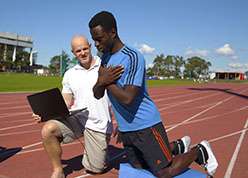Researcher invents on-field 'hammy' tester

QUT has invented an on-field hamstring muscle tester that could save elite sports clubs hundreds of millions of dollars in lost player time.
QUT Faculty of Health lecturer and researcher Dr Tony Shield said even though the hamstring device was still at the prototype stage it had sparked interest from English premier league soccer clubs such as Manchester United, Liverpool and Chelsea.
"Hamstring muscle 'tears' are the most common sports injury in the world, with injured players typically missing three to six weeks of competition and training," he said.
"Players are also likely to reinjure the muscle in the 12 months following an initial injury."
QUT researchers are developing a portable device that could help single out those players most likely to 'do' their hamstring.
Dr Shield said the invention was currently being trialled by six AFL clubs and a number of elite track and field athletes including long jump Olympic silver medallist Mitchell Watt and his training partner and fellow Olympic finalist, Henry Frayne.
"The hamstring device aims to provide accurate measures of athletes' hamstring strength to conditioning and medical staff," he said.
"It should offer an affordable means of comparing strength between limbs and monitoring the progress that players make across the pre-season or in rehabilitation."
He said the device tested 'eccentric' strength - the amount of force that a muscle can generate while it lengthens.
"Hamstring muscles act eccentrically to slow down the forward movement of the legs in the 'swing' phase of running and most often become injured in high speed sprinting," he said.
"Previous research suggests that strength imbalances may predict players at greatest risk of hamstring strain."
Dr Shield said until now, eccentric hamstring strength and injury risk had been best measured using an isokinetic dynamometer, a large, heavy and immobile machine found in only a few dozen university exercise science facilities around the country.
"While providing excellent data, these devices are expensive ($80,000-$100,000) and inaccessible to all but the wealthiest sporting clubs and dynamometry is time consuming, with at least two full days required to test a squad of 40 or more AFL players," he said.
"Two of my post-graduate students recently tested a squad of 44 AFL players in two hours using the prototype of the QUT device."
The exercise performed on the hamstring device, commonly known as the Nordic hamstring curl, involves athletes falling forward as slowly as possible from a kneeling position.
"Typically this movement is performed with a training partner holding down the ankles and two large prospective injury prevention studies and one observational study have already shown that performing 'Nordics' regularly in the pre-season and the competitive season can reduce hamstring injury rates in soccer and rugby players," Dr Shield said.
"The QUT device replaces the training partner with ankle restraints that are fitted with wireless load cells which transmit force or strength data to a laptop computer.
"This provides almost instantaneous feedback on hamstring muscle strength which would otherwise be unavailable to coaching staff.
"Armed with this information a trainer can make a more informed decision on what types of strength training need to be employed and potentially whether a player is fit to take the field."
Hamstring injuries strike athletes at all levels of sport from the recreational to the nation's top sportspeople. Australian cricket captain Michael Clark, track and field star Sally Pearson and former Australian Wallaby captain James Horwill have all strained hamstring muscles.
"The goal of this device is to keep athletes like these and the weekend warriors on the field longer," Dr Shield said.
Dr Shield, a member of the Institute for Health and Biomedical Innovation, said development of the hamstring testing device was being funded by qutbluebox.
Dr Shield has also taken the hammy device to the Aspetar Orthopaedic and Sports Medicine Hospital in Qatar where he met with specialists keen to learn more about the device.
















